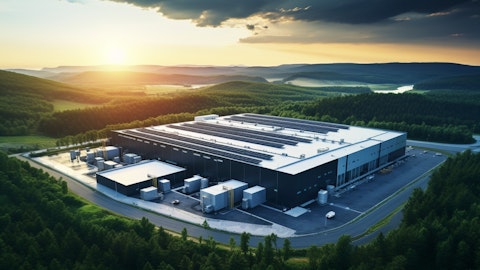VNET Group, Inc. (NASDAQ:VNET) Q2 2025 Earnings Call Transcript August 21, 2025
VNET Group, Inc. misses on earnings expectations. Reported EPS is $-0.01 EPS, expectations were $0.02.
Operator: Hello, ladies and gentlemen. Thank you for standing by for the Second Quarter 2025 Earnings Conference Call for VNET Group, Inc. [Operator Instructions] Participants from our management include Mr. Ju Ma, Rotating President; Mr. Qiyu Wang, Chief Financial Officer; Ms. Xinyuan Liu, Head of Investor Relations of the company. Please note that today’s conference call is being recorded. I will now turn the call over to the first speaker today, Ms. Xinyuan Liu. Please go ahead.
Xinyuan Liu: Thank you, operator. Hello, everyone, and welcome to our second quarter 2025 earnings conference call. Our earnings release was distributed earlier today, and you can find a copy on our IR site as well as on Newswire services. Please note that today’s call will contain forward-looking statements made under the safe harbor provisions of the U.S. Private Securities Litigation Reform Act of 1995. Forward-looking statements are subject to risks and uncertainties that may cause actual results to differ materially from our current expectations. For detailed discussions of these risks and uncertainties, please refer to our latest annual report and other documents filed with the SEC. VNET does not undertake any obligations to update any forward-looking statements, except as required under applicable laws.
Please also note that VNET’s earnings press release and this conference call include the disclosure of unaudited GAAP and non-GAAP financial measures. VNET’s earnings press release contains a reconciliation of the unaudited non-GAAP matters to the unaudited GAAP matters. A summary presentation, which we will refer to during this conference call, can be viewed and downloaded from our IR website at ir.vnet.com. Next, I’d like to alert you that we will be utilizing text-to-speech technology powered by Newlink.ai to deliver this quarter’s prepared remarks by Mr. Ju Ma, our rotating President; and Mr. Qiyu Wang, our CFO. The management team will join the Q&A session in person. Additionally, this conference is being recorded. A webcast of this conference call will also be available on our IR website at ir.vnet.com.
Now let’s get started with today’s presentation. Mr. Ma, please go ahead.
Ju Ma: Good morning, and good evening, everyone. Thank you for joining our call today. I’ll start with an overview of our major accomplishments during the second quarter of 2025. We delivered strong quarterly results, thanks to continued effective strategic execution. On the operational side, our wholesale IDC business maintained its significant growth momentum, supported by our customers’ fast move in pace. As of June 30, 2025, our wholesale capacity in service grew by 17.5% quarter-over-quarter to 674 megawatts, an increase of around 101 megawatts. Wholesale capacity utilized by customers rose by 17% quarter-over-quarter to 511 megawatts, an increase of around 74 megawatts, while the utilization rate was stable at 75.9%, reflecting a fast-moving pace in our wholesale data centers.
Our retail IDC business continued to progress smoothly, supported by growing AI-driven demand from customers. Both our high-quality wholesale and retail IDC services continue to attract customers from various industries in the second quarter. I’ll dig into those details on the next slide. On the financial side, both our revenues and adjusted EBITDA maintained solid growth. Specifically, our total net revenues increased by 22.1% year-over-year to RMB 2.43 billion for the second quarter. Notably, wholesale revenues reached RMB 854 million for the quarter, representing impressive year-over-year growth of 112.5%, fueled by the rapid growth of our wholesale IDC business. Our adjusted EBITDA for the second quarter also increased by 27.7% year-over-year to RMB 732 million with an adjusted EBITDA margin of 30.1%, up 1.3 percentage points year-over-year.
Moving on to our new order wins on Slide 5. In the second quarter, driven by growing demand from customers for intelligent deployment, we secured a combined capacity of around 4 megawatts in retail orders from customers in the IT services, Internet, AIoT and financial services sectors. These orders span multiple retail data centers in the Greater Beijing area, the Yangtze River Delta, the Greater Bay Area and other regions. Furthermore, we recently won a 20-megawatt wholesale order from a leading cloud services provider for the project we operate in Hebei province with our joint venture partner. As AI permeates every aspect of the world, new growth opportunities for data centers, the bedrock of AI infrastructure, continue to emerge. AI-driven demand remains especially robust in China, including training and inference demand from customers across multiple industries, conducting intelligent deployments.
To capture these opportunities and strengthen our competitiveness, we unveiled our Hyperscale 2.0 framework for the future of our AIDC development at our Investor Day in Wulanchabu in late June. We also outlined our blueprint for growing the capacity of our data center assets under management to 10 gigawatts by 2036. Driven by the proliferation of AI, the data center industry’s development has reached an inflection point where traditional IDCs are shifting to AIDCs to meet dynamic market demand. In parallel, data center business model is evolving from simply providing project-based capacity delivery to serving as a platform offering comprehensive AIDC solutions. As a pioneer in AIDC development with strong fundamentals and deep industry know- how, VNET is poised to shape this trend through our Hyperscale 2.0 framework.
Our innovative technologies enable us to construct high-quality, flexible AI DCs faster, ensuring rapid deliveries to meet customer needs. For example, our building standardization technology utilizes standardized modules as data centers’ core building units, allowing us to rapidly construct data centers tailored to diverse customer needs. This method cuts construction cycles by 1/3 compared to traditional construction methods. Additionally, our modular data center technology integrates various functions, including power supply systems, cooling systems, et cetera, into separate functional modules. These modules are manufactured and pretested in factories and shipped to data center sites for installation, which significantly enhances our installation efficiency.
They can also be swapped out, allowing us to selectively upgrade only specific modules instead of entire systems, reducing improvement costs and extending data centers life cycles. By leveraging these technologies, we can build quickly and combine modules with different functions flexibly to meet customer-specific requirements, ensuring fast capacity delivery to our customers. We believe these innovations position us as a frontrunner in the IDC industry going forward. Execution of our Hyperscale 2.0 framework is already underway, starting in Inner Mongolia, Hebei Province and Beijing, where we plan to establish data center hubs encompassing megawatt scale cabinets, 100-megawatt scale buildings and gigawatt scale campuses. Ultimately, as I mentioned earlier, we aim to manage a 10-gigawatt integrated data center asset cluster by 2036 that seamlessly combines computing power and energy management across multiple campuses, empowering us to shape the future development of AI DC solutions.

Now let’s delve into our business updates, starting with our wholesale business on Slide 8. Our wholesale business continued to grow rapidly, with capacity in service increasing by around 101 megawatts quarter-over-quarter to 674 megawatts and utilization rate remaining stable at 75.9% mainly attributable to our strong delivery capabilities at our N-OR Campus 01 and faster-than-expected move-ins at our N-OR Campus 01 and E-JS Campus 03. Our mature capacity utilization rate also reached 94.6%, a relatively high level. We have a clear growth path for our wholesale data center capacity. Let’s move on to Slide 9. Our overall wholesale data center capacity maintained its growth trajectory in the second quarter. Our capacity under construction was around 326 megawatts, with a precommitment rate for capacity under construction of 55.2% as of the end of June.
Capacity held for short-term future development was around 374 megawatts and capacity held for long-term future development was around 418 megawatts as we remain confident in the long-term growth potential of AI-driven demand. Moving to our retail IDC business on Slide 10. Our retail business continued to progress smoothly in the second quarter. Retail capacity in service was 52,131 cabinets, with the utilization rate increasing slightly to 63.9% as of the end of June, MRR per retail cabinet increased to RMB 8,915 this quarter. Turning to our delivery plan on Slide 11. With our robust and efficient delivery capabilities, we successfully delivered a total of around 188 megawatts in the first half of 2025. We currently have 8 data centers under construction with 6 in the Greater Beijing area and 2 in the Yangtze River Delta.
We plan to deliver around 326 megawatts of capacity over the next 12 months or around 227 megawatts during the second half of 2025 and around 99 megawatts during the first half of 2026. This ambitious delivery plan reflects strong demand from our customers and our outstanding delivery prowess. Now turning to our non-IDC business, a key component of our business. [indiscernible] further expanded its customer base by winning new customers in the consulting and intelligent driving industries for its premium dedicated Internet services, VPN services, IDC services, and cloud services. In conclusion, our robust second quarter results further validate our core strengths and effective strategic execution. Looking ahead, we will continue to sharpen our competitive advantages with faster deliveries and consistently reliable IDC services as we embark on our ambitious hyperscale 2.0 framework to build greener, more intelligent data centers for the AI era.
And as always, we will remain committed to driving innovation and fostering industry development as we grow, delivering value to all of our stakeholders. Now I will turn the call over to our CFO, Qiyu, for further discussion of our operating and financial performance. Thank you, everyone.
Qiyu Wang: Good morning, and good evening, everyone. Before we start the detailed discussion of our second quarter performance, please note that unless otherwise stated, all the financials we present today are for the second quarter of 2025 and are in renminbi terms. Furthermore, unless otherwise specified, all the growth rates I’m reviewing are on a year-over-year basis. Let’s turn to Slide 13. In the second quarter, we continued to pursue high-quality, high-margin business. Our total net revenues increased by 22.1% to RMB 2.43 billion, mainly driven by the rapid growth of our wholesale business. Our adjusted cash gross profit rose by 34.9% to RMB 1.06 billion, while our adjusted EBITDA also grew year-over-year by 27.7% to RMB 732.5 million.
Let’s look more closely at our top line. As you can see on Slide 14, in the second quarter, wholesale revenues, our key revenue growth driver, increased significantly by 112.5% to RMB 854.1 million, mainly attributable to sales at the N-OR Campus 01 and E-JS Campus 03. Retail revenues continue to account for the largest part of our total net revenues, reaching RMB 959 million for the second quarter. Our non-IDC business revenues were RMB 621 million for the second quarter. During the second quarter, we maintained solid margins, thanks to our continuous efforts to enhance overall efficiency. As shown on Slide 15, our adjusted cash gross margins improved to 43.6% from 39.5% in the same period last year. Our adjusted EBITDA margin rose to 30.1% compared with 28.8% in the same period last year.
Moving on to liquidity. On Slide 16, we maintained robust and healthy liquidity, bolstered by a net operating cash inflow of RMB 366.6 million during the second quarter, bringing the net operating cash flow for the first half of the year to RMB 562.3 million. Our cash positions remained solid with total cash and cash equivalents, restricted cash and short-term investments reaching RMB 4.66 billion as of June 30, 2025. Next, let’s take a look at our debt structure on Slide 17. We maintained our prudent approach to debt management. As of June 30, 2025, our net debt to the trailing 12 months adjusted EBITDA ratio was 5.3 and total debt to the trailing 12 months adjusted EBITDA ratio was 6.4, both remaining at healthy levels. Also, our trailing 12 months adjusted EBITDA to interest coverage ratio was 6.9. We prioritize long-term debt maturity planning in our debt and strategic management to ensure the security of debt repayment.
Additionally, the company’s short- and medium-term debt maturing in 2025 to 2027 comprises 44.1% of our total debt. Turning now to CapEx spending. As you can see on Slide 18, for the first half of 2025, our CapEx was RMB 3.89 billion, with the majority allocated to the expansion of our wholesale IDC business. We still expect our CapEx for the full year 2025 to be in the range of RMB 10 billion and RMB 12 billion. The increase is mainly to support our planned delivery of 400 to 450 megawatts in 2025 or approximately 3x 2024’s total deliveries and surpassing our total deliveries in the past 3 years combined. Furthermore, in late June, our Board authorized a buyback program under which we may repurchase up to USD 50 million from time to time on the open market over the ensuing 12 months.
The buyback program underscores our deep commitment to delivering value to shareholders and our confidence in VNET’s future development and growth prospects. Now moving to our full year guidance for 2025 on Slide 19. As we announced in a press release in late June, we have increased our full year revenue and adjusted EBITDA guidance, fueled by faster-than-anticipated move-ins among wholesale IDC customers and ongoing operational efficiency gains. We now expect total net revenues to be in the range of RMB 9.15 billion to RMB 9.35 billion, a year-over-year increase of 11% to 13% and adjusted EBITDA to be in the range of RMB 2.76 billion to RMB 2.82 billion, representing a year-over-year increase of 14% to 16% if the RMB 87.7 million on disposal gain of E-JS 02 data center were excluded from the adjusted EBITDA calculation for 2024.
The year-over-year growth would be 18% to 20%. Before I conclude, I’d like to briefly update you on our ESG efforts. We were pleased to receive an A grade, the highest rating in the 2024 Supplier Engagement Assessment by the Carbon Disclosure Project. We were also recognized as a supplier engagement leader for our collaboration with supply chain partners on low-carbon technology, R&D, enhancing our IDC operational energy efficiency and empowering our partners to save energy and reduce emissions. Looking ahead, we will remain steadfast in our pursuit of ESG excellence, embracing and promoting a green future. In summary, we maintained our business’ vibrant momentum with strong financial results during the second quarter, supported by our effective dual core strategy and new Hyperscale 2.0 framework.
We’re well positioned to lead the AIDC transformation, capturing surging AI-driven opportunities and delivering sustainable long-term value for all stakeholders. This concludes our prepared remarks for today. We are now ready to take questions.
Q&A Session
Follow 21Vianet Group Inc. (NASDAQ:VNET)
Follow 21Vianet Group Inc. (NASDAQ:VNET)
Receive real-time insider trading and news alerts
Operator: [Operator Instructions] Your first question comes from Tom Tang with Morgan Stanley.
Yue Tang: And first of all, congratulations on very strong quarterly results, especially on the wholesale business. So my question is mainly about the future demand and orders. So we noticed that NVIDIA has regained its permission to ship their new chipsets to China again last month. So just wondering, based on our communication with our big customers, what is our current expectation of their future demand and the pattern of their order tendering? [Foreign Language]
Unidentified Company Representative: [Foreign Language]
Unidentified Company Representative: Thank you for your question. And now the market is relatively active. And according to the report of the third party institutions, we find that in the regions where the digital economy is relatively active, for example, in the Greater Beijing area and in the Yangtze River Delta, I think the AI demand is relatively strong and also the relation between supply and demand has improved a lot.
Unidentified Company Representative: [Foreign Language]
Unidentified Company Representative: And your question is also mentioned about the bidding and also the demand for the big client. Since you also have noticed that this year, our delivery plan is over 400 megawatts, it is relatively large. And also the new orders should be delivered in 6 months. So we will pay more attention to the demand released around September.
Unidentified Company Representative: [Foreign Language]
Unidentified Company Representative: So in addition to the 20-megawatt wholesale business, I think we are also paying a lot of attention to the potential demand, and we are also communicating for this potential demand. I think most of them are highly relevant to the AI.
Operator: Your next question comes from Edison Lee with Jefferies.
Edison Lee: I have 2, right? Number one, can you update us on the build-out of wind power in Ulanqab and when that will actually come into effect and how that’s going to impact the revenue and also the margin of the company? Number two, can you comment on your MSR on wholesale because it seems that your MSR or your MRR on the wholesale in the second quarter is actually up on a year-on-year basis. So maybe if you can explain a little bit what is driving that unit price, that will be great. [Foreign Language]
Unidentified Company Representative: [Foreign Language]
Unidentified Company Representative: I think now the wind power project in Ulanqab is well underway. I think by the end of this year and also in the beginning of next year, it will go to deliver power. But I think this is relatively a new trial for us, so we cannot expect impact on our P&L. However, I think it will mainly deliver positive impact on our IR. So I think the details on the statistics and the figures will be offered when it began to deliver power.
Unidentified Company Representative: [Foreign Language]
Unidentified Company Representative: And so for the second question, I think it has 2 factors. The first one is I think the wholesale price is relatively very stable. And you also mentioned that the improvement in MSR, I think it’s mainly due to the seasonal effect factors because of the increase in the revenue from the electricity bills and also in this quarter, we have the one-off income.
Operator: Your next question comes from Daley Li with BofA Securities.
Huiqun Li: I have 2 questions here. The first one is regarding our gross margin. Our adjusted gross margin was quite a healthy growth and improvement. And for our GAAP level, gross margin, if we look at quarter-on-quarter, it seems dropped a little bit and what’s the reason behind this? And how do you think the future normalized gross profit margin? Second question about the new financing channel, the REITs. Could you please update us on the progress of the private REITs and the C-REITs going forward? [Foreign Language]
Unidentified Company Representative: [Foreign Language]
Unidentified Company Representative: Thank you for your question. For the changes in the GP margin, I think it’s affected by the timing of turning the [indiscernible] into [PPE] and also the depreciation. So there can be some seasonal factors that leads to the fluctuation. But if we exclude the — if we only consider the cash GP margin, I think it’s still varied on a healthy and a steady increase.
Unidentified Company Representative: [Foreign Language]
Unidentified Company Representative: And also for the REIT project, we have been actively promoting the REIT projects. We have the public and also the private REITs. And I think we have and also, as mentioned, this year through the REITs project, we have to have a recovery of RMB 2 billion.
Operator: Your next question comes from Timothy Zhao with Goldman Sachs.
Timothy Zhao: Great. Congrats on the very strong results. Two questions here as well. First is regarding your guidance, pretty glad to see that you raised guidance actually 2 months ago. But after the very strong first half results, just wondering how management thinks about the second half outlook? So if my calculation is correct, I think towards the high end of your guidance, I think the second half growth implied only around single-digit growth. Just wondering how should we think about the second half outlook? Secondly is regarding the retail IDC business. As I see there is some revenue decline on this retail IDC revenue in the second quarter of this year versus a stronger first quarter. Just wondering what is the reason behind? [Foreign Language]
Unidentified Company Representative: [Foreign Language]
Unidentified Company Representative: Thank you for your question. As mentioned, in spite of the upgrading in the guidance, I think the guidance for the second half of this year is still relatively conservative. So our consideration is that we needed to watch — we need to watch and see that if the utilization speed and the pace of our customers or clients will not be affected by the chips. And if our wholesale utilization business can maintain its speed, I think we can upgrade the guidance for the second half of the year.
Unidentified Company Representative: [Foreign Language]
Unidentified Company Representative: And your second question is relatively to the IDC revenue from — for the retail business. Yes, there can be some slight decline, but I think it’s still within the reasonable range. And I think the revenue for the retail IDC will maintain a relatively stable and even some increase.
Operator: Your next question comes from Andy Yu with DBS.
Andy Yu: Congratulations on solid results. So I have a question regarding the second half outlook. Could management share some color on whether the rapid momentum of our client movement can be sustained? Also, do we expect that the impact of AI chip supply constraints could affect senior orders or customer movements in the second half of ’25? Let me translate the question. [Foreign Language]
Unidentified Company Representative: [Foreign Language]
Unidentified Company Representative: So as for the outlook for the second half of this year. I think if we compare the second half with the first half of this year, I think, I am relatively optimistic about the second half because if we take into account the delivery of the — delivery in the first half of this year, and we will also closely follow the rules of the new orders unleashed by our clients. And I think we will be very optimistic generally about the second half of this year. And also as for the move-in pace of our clients, I think according to the practice once the order has been confirmed, we usually have very fast move in pace.
Unidentified Company Representative: [Foreign Language]
Unidentified Company Representative: And also as for the supply of the chips of AI, we will closely follow the companies like [NVIDIA chips] and also the domestic chips. And I think the expectation will be very clear, very soon. As also according to our experiences of serving our clients or customers, I think once the order is confirmed, the move-in pace will be very fast. And also as for the wholesale business, we have also confirmed with the core clients that the orders at hand for rest of our clients will not be affected.
Operator: Your next question comes from Sara Wang with UBS.
Xinyi Wang: Thank you for the opportunity to ask a question. And again, congratulations on the very solid results. I only have one question — is that management just mentioned that there could be potential new tenders from the customers. Do we expect similar customers and similar workload going forward? Or there could be some change? [Foreign Language]
Unidentified Company Representative: [Foreign Language]
Unidentified Company Representative: So thank you for your question. I think our clients unleash their demand gradually. And from the demand side, I think in terms of the business, the demand for AI remain unchanged.
Operator: Your next question comes from [indiscernible] with CICC. We will just pause for a moment to see if we’ll have [indiscernible] back in the queue. That does conclude our call and conference for today. Thank you for participating. You may now disconnect.
Follow 21Vianet Group Inc. (NASDAQ:VNET)
Follow 21Vianet Group Inc. (NASDAQ:VNET)
Receive real-time insider trading and news alerts




